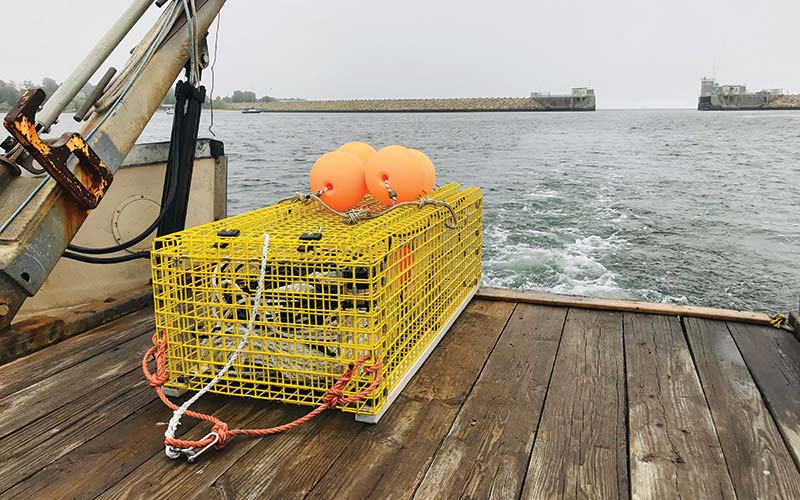
On-demand, also called ropeless, gear systems will reduce the risk of gear entanglement for right whales and other large marine mammals while allowing lobster fishermen to continue fishing. Photo: Edgetech
With fewer than 350 North Atlantic right whales left on the planet, the species is one step away from extinction. Humans pose the biggest threat to their survival due to entanglements with fishing gear and collisions with ships and boats. Ropeless fishing gear (also called “on-demand,” “pop-up,” and “buoyless” systems) offers a promising solution to entanglements by eliminating the deadly maze of vertical lines that connect buoys on the surface with traps on the seafloor.
The idea of fishing without vertical lines has been around for a while. The reality requires investments in new equipment and an adjustment in longstanding, cultural fishing practices – which can be a tough sell for the fishing community.
But affordability has been the real showstopper. Switching one boat to ropeless fishing gear can be expensive enough, let alone an entire fleet. We wanted to understand just how expensive – and what it would take for those costs to come down.
We analyzed two illustrative sectors of the commercial lobster fishery and detail the findings in a new report. It will come as no surprise that the costs are significant – topping $24 million to convert 70 offshore permit holders to ropeless gear in one sector and $125 million to outfit 409 nearshore boats in the other. However, we project that the costs of this innovative new gear could drop by as much as 50% as its adoption scales up – just like with any new technology.
NOAA Fisheries recently described ropeless gear systems as “the best solution to separate rope and right whales in areas of highest risk.” It’s time for the agency and Congress to put weight behind these words. Legislation passed late last year dedicates monies to fund innovative gear technologies and directs NOAA to take action to make this transition a reality. Private sector investment also will be needed.
We hope this report provides a starting point for determining and securing the funding needed now and into the future to create a healthy ocean where both whales and fishermen can thrive.
Our Approach to Modeling the Costs to Transition to Ropeless Fishing Gear
Several factors went into the financial model we created for this report: the cost of outfitting a particular vessel, the current pricing of ropeless gear systems, and regulatory requirements that impact how and where a vessel can fish, among others. We then determined where readily available data helps account for these factors.
We found two sectors provided the most complete data for our modeling: Massachusetts state-permitted fishermen operating with boats 30 feet or longer in nearshore Lobster Management Area 1 or LMA1 (which is marked in its entirely in teal on this map) and federally permitted lobstermen fishing far offshore in Lobster Management Area 3 or LMA3 (shown in blue on this map).
We then chose a gear manufacturer to base costs on – one that represents a midpoint in pricing across current manufacturers. Fishermen using gear from other manufacturers could see higher or lower costs.
To estimate the cost of outfitting a particular vessel, we also included the costs of the necessary equipment: a deck box, a hull-mounted transducer, some number of ropeless release systems (and associated cages and buoys) attached on one or both ends of the trawls, and the software necessary to mark and release gear.
Ropeless Gear Costs are High Right Now But Can Drop with Increases in Production Volume
We found that converting all vessels 30 feet in length or more in the nearshore Massachusetts Lobster Management Area 1 fishery would cost approximately $128 million. Converting all 70 active permit holders in Lobster Management Area 3 would amount to roughly $24 million.
Exact costs depend on several factors. For example, fully equipping a nearshore vessel that sets 500 traps, with 11 traps on each trawl, and uses one ropeless release per trawl, would cost an estimated $227,000 today. On the other hand, fully equipping an offshore vessel that sets 1,900 traps, with 45 traps on each trawl, and uses two ropeless releases per trawl, would cost roughly $344,000.
These costs are significant. However, they should not be considered a reason to dismiss ropeless gear as a viable solution. Instead, they should be viewed as an incentive for further investment. Here’s why.
To date, only a limited number of ropeless gear systems have been built and installed. And the fishermen using these systems continue to provide input on how to modify them. So, their manufacturing volume has yet to reach the tipping point to achieve economies of scale. But if just the two sectors of the industry we analyzed fully converted, the volume of gear produced would dramatically increase.
That, in turn, could reduce the cost per vessel by about 50% for the two sectors we modeled, based on a conservative learning rate reflecting a high degree of manufacturing automation and the gear volumes noted above. Fleetwide conversion costs would then drop to $62 million for Management Area 1 and $13 million for Management Area 3. And if portions of the Maine fishery were to convert, it would drive even more volume and reduce costs further.
Our report also models the theoretical financial benefit of reduced gear loss, as release systems sending an acoustic signal describing their location could be easier to find if moved in a storm or by another vessel.
Our results provide a snapshot of costs based on the data available in late 2022. As new technologies evolve, we may see different costs and volume assumptions.
Congress Recently Passed a Spending Bill that Could Fund the Transition
Late last year, Congress passed a spending bill that sets aside $20 million in fiscal year 2023 and potentially another $500 million over the next ten years to fund technologies that will reduce the toll of human activities on right whales. Based on our current model, these authorized funds could, if properly appropriated, make the transition to ropeless gear a reality.
It is also imperative that ropeless gear is safe, reliable, and efficient for fishermen. Ongoing gear tests supported by NOAA here in Massachusetts are helping to provide valuable feedback to manufacturers to ensure fishermen feel confident about using the gear in all kinds of conditions.
Ropeless Gear Can Allow Fishing to Continue and Give Right Whales a Fighting Chance
Ropeless fishing gear, properly subsidized, would allow lobster fishermen to continue fishing while giving North Atlantic right whales a better chance of survival as a species. Without this transition, fishermen face widespread closures of areas where right whales congregate – and right whales face a dangerous ocean that puts their lives and entire future at risk.



